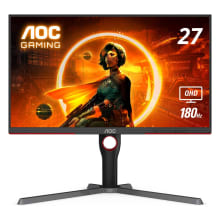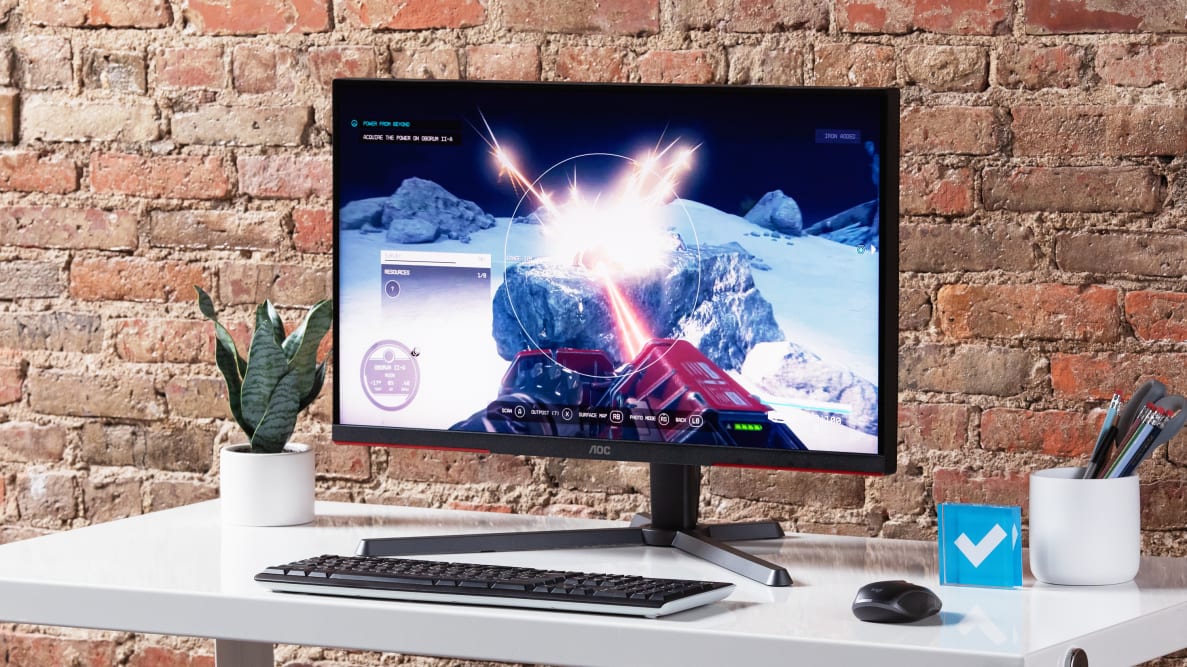Pros
-
Excellent image quality
-
Super bright HDR
-
Good motion clarity
Cons
-
No USB connectivity
-
Confusing menus
-
Blooming around bright objects
About the AOC Q27G3XMN

The AOC Q27GX3MN is an outstanding performer across all metrics.
The AOC Q27G3XMN’s specifications may not seem remarkable at first glance. It uses a 27-inch, 2560 x 1440 VA panel with a 180Hz refresh rate and supports Adaptive Sync, all of which are typical for a gaming monitor priced just south of $300.
But the AOC has a feature its competition lacks: a mini-LED backlight. The backlight provides 336 dimming zones that operate independently of the others. They can turn off completely one moment, then ramp up to 1,200 nits the next. The Q27G3XMN is the only mini-LED monitor currently available for less than $450 (in North America, at the least), and the backlight delivers a huge boost to SDR and HDR image quality.
AOC Q27G3XMN specs
- Price: $280
- Display Size: 27-inch widescreen
- Resolution: 2,560 x 1,440
- Refresh rate: 180Hz
- Peak brightness: 1000 nits HDR (claimed), 1204 nits HDR 100% window (measured), 1134 nits HDR 50% window (measured), 903 nits HDR 10% window (measured)
- HDR support: HDR10, VESA DisplayHDR 1000 Certified
- Color depth: 8-bit + FRC
- Color saturation: sRGB 100% (measured), DCI-P3 96% (measured), AdobeRGB 95% (measured)
- Contrast ratio: Infinite (tested at 50% brightness), 25,200:1 (tested at 100% brightness)
- Pixel response time (GtG): 1 millisecond (claimed)
- Ports: 2x HDMI 2.0, 1x DisplayPort 1.4, 1x 3.5mm audio-out
- VRR Support: Adaptive Sync
- Special features: 100mm x 100mm VESA mount, mini-LED backlight with 336 dimming zones
What we like
It looks spectacular, especially in HDR

The AOC AOC Q27GX3MN's mini-LED backlighting allows for spectacularly bright peaks.
I’ll be honest. I was extremely skeptical of the AOC Q27G3XMN when it arrived at my door. The monitor retails for about $280 but packs a 1440p panel with a mini-LED backlight. It even boasts VESA DisplayHDR 1000 certification, a badge normally found on far more expensive displays. How could it do all that for less than $300?
I’m not sure what budgetary magic AOC Q27G3XMN works to make this possible. But I am sure of one thing: the magic is real.
Our tests proved the AOC Q27GXMN is an outstanding performer across all metrics. It can get extremely bright, achieving almost 500 nits in SDR mode and over 1200 nits with HDR enabled. The contrast ratio was never less than 25,200:1 (at maximum brightness) with the dynamic mini-LED backlight enabled, and much better than that at lower levels of brightness. Color performance was great, too: we’re talking 100% of sRGB, 96% of DCI-P3, and 95% of AdobeRGB.
In short, the AOC Q27G3XMN is vibrant, rich, immersive, and can get eye-searingly bright when displaying HDR content.
The “Into the Storm” scene from Mad Max: Fury Road gave the Q27G3XMN a chance to strut its stuff. This clip features shockingly brilliant lightning strikes raining down amid a dark and rusty sandstorm. It’s a tough test for most displays, but the Q27G3XMN shined. A few bolts of lightning were so sharp that I physically flinched even though I knew they were coming.
HDR games also look excellent, provided they lean into the medium’s strengths. Diablo IV looked appropriately dark and murky, but it didn’t take full advantage of the monitor’s peak brightness. Forza Horizon 5, on the other hand, was simply gorgeous, especially in events that pair vistas with an alluring sunset or sunrise.
SDR content is not as bright, of course, but it still benefits from the monitor’s fundamentally strong contrast and color performance. Games with a colorful presentation look saturated and lively, while darker games are appropriately abyssal and foreboding.
It’s honestly a shock to see the AOC Q27G3XMN perform as well as it does, as it effectively eliminates a huge swath of budget contenders from consideration. Many similarly priced competitors, such as the LG UltraGear 27GL83A-B and Dell G2724D, perform far worse than the AOC and are now effectively obsolete.
Motion clarity is good for the price
The AOC Q27GX3MN delivers a refresh rate of up to 180Hz alongside Adaptive Sync support. These features combine for strong motion clarity.
Boosting the maximum refresh rate to 180Hz reduces input latency and improves motion fluidity in games that render at high frame rates. Fast-moving objects show modest motion blur but quickly panning the camera (as you might while viewing the scenery in a role-playing game) still retains significant detail.
This monitor uses a Vertical Alignment (VA) panel, a technology that often has smearing issues when dark objects move across a brighter background. The issue remains slightly visible, but it didn’t leap out to me unless I looked at test images explicitly meant for that purpose. It’s not noticeable in day-to-day use.
The Q27GX3MN does have limits. Scrolling test images from DOTA 2 showed that while terrain and character silhouettes were easy to make out, character names and hitpoint bars were hard to see. Most monitors with a 240Hz refresh rate make such fine details visible, and the least expensive 240Hz monitors are more affordable than the Q27GX3MN. But budget 240Hz monitors often deliver less impressive visuals overall.
AOC doesn’t officially list AMD FreeSync or Nvidia G-Sync support with the Q27GX3MN, but both worked without issue in my testing. This is expected behavior. AMD FreeSync and Nvidia G-Sync are built on Adaptive Sync standards and usually function with any Adaptive Sync monitor.
AOC didn’t cut corners

AOC includes a versatile, sturdy stand with a range of motion not commonly found on other displays under $300.
The AOC’s Q27G3XMN’s budget price and beautiful image quality seem too good to be true. Surely AOC had to sacrifice something, right? It did, but build quality isn’t where the obvious corners were cut.
That’s not to say the monitor looks great. It's a generic mishmash of matte black plastics and lacks flair. Still, the build quality feels more than adequate. The plastics used are no less durable than the competition and the monitor’s thick display panel (a result of the mini-LED backlight) provides a sense of heft.
The stand punches above its weight. It attaches to the display panel with a 100mm x 100mm VESA mount and supports the full range of ergonomic adjustments including height, tilt, swivel, and 90 degrees of pivot for use in portrait orientation. Most monitors in the Q27G3XMN’s price bracket also have an ergonomic stand, but it’s nice to see the monitor’s above-average image quality didn’t force AOC to cut back on ergonomics.
What we don’t like
The on-screen menus are a mess

Navigating the OSD is more frustrating than it needs to be.
The AOC Q27G3XMN delivers great image quality, good motion clarity, decent design, and even has an ergonomic stand. But one feature falls short: the monitor’s on-screen menu system.
AOC sticks to an old-school, button-based control scheme instead of the joystick-style controls found on most recent monitors. Buttons get the job done but are slower and less intuitive than a joystick. It’s often unclear which button should do what, especially when navigating through menu options. The menu options are arranged vertically but the buttons are arranged horizontally, so moving up and down requires a tap left or right. It never feels intuitive.
The menu system’s arrangement is also a bit strange. Opening the main menu displays a grid of six options, each represented only by an icon and a single word, and there’s no visual indication of the options nested under these six broad categories. Finding the right options requires trial and error.
Image calibration is limited. The monitor has three gamma modes, but those modes don’t target a specific gamma curve, and color temperature targets vague labels such as “warm” and “normal.” To be fair, though, the Q27G3XMN’s calibration options are similar to most other budget monitors.
There are a few gaming features including an on-screen crosshair, FPS counter, and a Shadow Control mode that can boost the brightness of dark areas of games to make foes easy to see. These are expected features, though, and available on most competing monitors.
Connectivity is limited
AOC sticks to the basics for connectivity. The monitor has two HDMI 2.0 ports, one DisplayPort 1.4, and a 3.5m audio-out jack.
It’s not a terrible selection of connectivity for a budget gaming monitor. Providing two HDMI ports and one DisplayPort is a popular choice, as it lets players connect two game consoles and one PC simultaneously.
However, many monitors around $300 at least include a pair of USB-A ports, and some include USB-C. The Gigabyte M27Q, Dell G3223D, and Pixio PX275C Prime all deliver better USB-C and/or USB-A connectivity at a similar or lower price.
The mini-LED backlight is good, but not perfect
The AOC Q272G3XMN’s performance is made possible by a mini-LED backlight with 336 dimming zones. Each zone can adjust brightness independently of the others, which improves the monitor’s contrast. But it’s not perfect.
Mini-LED backlights tend to show blooming, an issue visible as bright halos that seem to “bloom” around bright objects. AOC manages this problem better than expected, as 336 dimming zones aren’t a lot (the best mini-LED displays have over 2,000). Still, blooming is visible in scenes with small, bright objects on a dark background.
I also noticed problems with motion when small high-contrast objects move across the display. This caused a strobing or pulsing effect as the object moved between dimming zones. I never noticed the issue in real-world use, but it was visible in videos designed to test a mini-LED display’s backlight.
Turning the dynamic mini-LED backlight off solves these problems but lowers the contrast ratio to a measured maximum of 5,210:1. That’s not a great trade in most situations, but it can prove useful at times and is still well above the 1,000:1 standard contrast rating of an IPS panel. I find any fluctuation in brightness annoying while I write or edit, so I turned the dynamic backlight off while working.
Should you buy the AOC Q27G3XMN?
Yes, it delivers outstanding image quality on a budget

The AOC Q27G3XMN is the only mini-LED gaming monitor on the market for under $300.
The AOC Q27G3XMN turns the budget monitor market on its head. It forces a tough question: if a monitor this inexpensive can perform this well, why would anyone buy anything else for under $300?
There are reasons, of course. The Q27G3XMN has a few flaws, including limited image calibration capabilities and lack of USB ports, which are sure to take it out of contention for some shoppers. Some might prefer the Dell G2724D for its improved connectivity and attractive design; others might prefer a smaller monitor with a higher refresh rate and even better motion clarity, like the Samsung Odyssey G4.
But if you want a monitor for gaming, entertainment, and entry-level content creation in both SDR and HDR, the AOC Q27G3XMN is simply unbeatable. It delivers image quality and HDR performance that often exceeds monitors sold for two to three times its price.

The AOC Q27G3XMN sets a new standard for sub-$300 gaming monitors thanks to its mini-LED backlighting.
Meet the tester
Matthew S. Smith is a veteran tech journalist and general-purpose PC hardware nerd. Formerly the Lead Editor of Reviews at Digital Trends, he has over a decade of experience covering PC hardware. Matt often flies the virtual skies in Microsoft Flight Simulator and is on a quest to grow the perfect heirloom tomato.
Checking our work.
Our team is here to help you buy the best stuff and love what you own. Our writers, editors, and experts obsess over the products we cover to make sure you're confident and satisfied. Have a different opinion about something we recommend? Email us and we'll compare notes.
Shoot us an email




